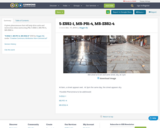
A given phenomenon that will help drive units and instruction when instructing PEs: 5-ESS2-1, MS-PS1-4, MS-ESS2-4
- Subject:
- Applied Science
- Environmental Science
- Physical Science
- Material Type:
- Teaching/Learning Strategy
- Date Added:
- 12/14/2018

A given phenomenon that will help drive units and instruction when instructing PEs: 5-ESS2-1, MS-PS1-4, MS-ESS2-4
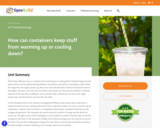
This unit on thermal energy transfer begins with students testing whether a new plastic cup sold by a store keeps a drink colder for longer than the regular plastic cup that comes free with the drink.
Through a series of lab investigations and simulations, students find two ways to transfer energy into the drink: (1) the absorption of light and (2) thermal energy from the warmer air around the drink. They are then challenged to design their own drink container that can perform as well as the store-bought container, following a set of design criteria and constraints.
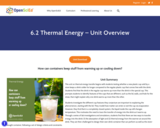
Unit Summary
This unit on thermal energy transfer begins with students testing whether a new plastic cup sold by a store keeps a drink colder for longer compared to the regular plastic cup that comes free with the drink. Students find that the drink in the regular cup warms up more than the drink in the special cup. This prompts students to identify features of the cups that are different, such as the lid, walls, and hole for the straw, that might explain why one drink warms up more than the other.
Students investigate the different cup features they conjecture are important to explaining the phenomenon, starting with the lid. They model how matter can enter or exit the cup via evaporation However, they find that in a completely closed system, the liquid inside the cup still changes temperature. This motivates the need to trace the transfer of energy into the drink as it warms up. Through a series of lab investigations and simulations, students find that there are two ways to transfer energy into the drink: (1) the absorption of light and (2) thermal energy from the warmer air around the drink. They are then challenged to design their own drink container that can perform as well as the store-bought container, following a set of design criteria and constraints.
This unit builds toward the following NGSS Performance Expectations (PEs) as described in the OpenSciEd Scope & Sequence: MS-PS1-4*, MS-PS3-3, MS-PS3-4, MS-PS3-5, MS-PS4-2*, MS-ETS1-4. The OpenSciEd units are designed for hands-on learning and therefore materials are necessary to teach the unit. These materials can be purchased as science kits or assembled using the kit material list.
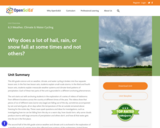
The goals of OpenSciEd are to ensure any science teacher, anywhere, can access and download freely available, high quality, locally adaptable full-course materials. REMOTE LEARNING GUIDE FOR THIS UNIT NOW AVAILABLE!
This unit on weather, climate, and water cycling is broken into four separate lesson sets. In the first two lesson sets, students explain small-scale storms. In the third and fourth lesson sets, students explain mesoscale weather systems and climate-level patterns of precipitation. Each of these two parts of the unit is grounded in a different anchoring phenomenon.

This activity introduces the role of diffusion in supplying cells with nutrients and removing wastes.
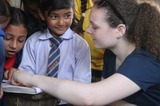
This book is intended for use by future teachers, written from the perspective of students who have taken Science Methods II. The student authors gathered and created resources to help prospective elementary cience teachers better understand science and feel confident in your abilities as a future teacher.
This book is divided into five parts which align with the Science Methods II course:
Physics
Space Science
Earth Science
Climate Science
Course Materials and Pedagogy
Within each part, the material is broken down into smaller chapters. Here you will find written explanations, video links, glossary terms, key takeaways, and practice quizzes to help you understand the material. This book is designed to be a flexible resource; use it as much or as little as you need throughout the course.
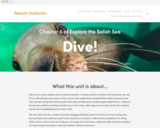
Did you know that a elephant seal can hold its breath for 77 minutes and dive 5,000 feet (1524 meters) into the sea? We are still working on the science to discover just what enables these remarkable feats under intense pressure, cold, and dark. Diving birds and mammals utilize physical, behavioral, and physiological adaptations to withstand the extreme conditions of diving and still return to the surface with oxygen reserves (and a meal!). Your students can join us in investigating just how they do this.
This unit will review the concepts of pressure-changing with depth, marine food webs, structure and function, photosynthesis and respiration, and of course, the process of science. It will introduce metabolism, the diving reflex, sensory structures for detecting prey, wave properties of acoustics, trophic pyramids, and bioaccumulation of toxins in long-lived predators. Oh yeah, and there will be orca forensics!
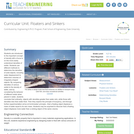
Students are introduced to the important concept of density with a focus is on the more easily understood densities of solids. Students use different methods to determine the densities of solid objects, including water displacement to determine volumes of irregularly-shaped objects. By comparing densities of various solids to the density of water, and by considering the behavior of different solids when placed in water, students conclude that ordinarily, objects with densities greater than water sink, while those with densities less than water float. Then they explore the principle of buoyancy, and through further experimentation arrive at Archimedes' principle that a floating object displaces a mass of water equal to its own mass. Students may be surprised to discover that a floating object displaces more water than a sinking object of the same volume.
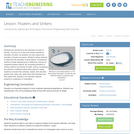
This lesson introduces students to the important concept of density. The focus is on the more easily understood densities of solids, but students can also explore the densities of liquids and gases. Students devise methods to determine the densities of solid objects, including the method of water displacement to determine volumes of irregularly-shaped objects. By comparing densities of various solids to the density of water, and by considering the behavior of different solids when placed in water, students conclude that ordinarily, objects with densities greater than water will sink, while those with densities less than water will float. Density is an important material property for engineers to understand.
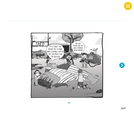
The Hot Balloon game lets you control the altitude of the balloon through heating the balloon or releasing air from the air flaps. Hot air rises the balloon through a force called buoyancy. The difference between the outside and the inside air determines the amount of buoyancy. Using weight difference, wind speeds and limited fuel the balloon can go on the farthest rides.
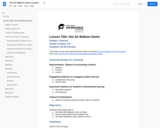
Students will be better able to discuss and describe what happens when air heats, and test their hypothesis with a hands-on demo
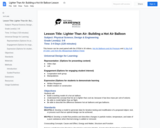
Students will build a working model of a hot air balloon

Have you ever passed a pond or swamp and seen bugs walking on the water? Find out how they do it in this Smithsonian Lightning Lesson.
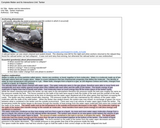
This resource is a phenomenon-based adaption to the Smithsonian's STCMS Matter and Its Interactions kit. The anchoring phenomenon event features a railroad tanker that collapses due to the phase changes of water that was used to clean it. Students will investigate what causes phase changes, energy transfer, thermal energy, the law of conservation of mass, and atoms and molecules throughout the three week unit.
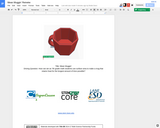
Driving Question: How can we as 7th grade math students use surface area to make a mug that retains heat for the longest amount of time possible?

Monitor the temperature of a melting ice cube and use temperature probes to electronically plot the data on graphs. Investigate what temperature the ice is as it melts in addition to monitoring the temperature of liquid the ice is submerged in.
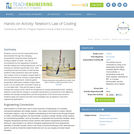
Students come to see the exponential trend demonstrated through the changing temperatures measured while heating and cooling a beaker of water. This task is accomplished by first appealing to students' real-life heating and cooling experiences, and by showing an example exponential curve. After reviewing the basic principles of heat transfer, students make predictions about the heating and cooling curves of a beaker of tepid water in different environments. During a simple teacher demonstration/experiment, students gather temperature data while a beaker of tepid water cools in an ice water bath, and while it heats up in a hot water bath. They plot the data to create heating and cooling curves, which are recognized as having exponential trends, verifying Newton's result that the change in a sample's temperature is proportional to the difference between the sample's temperature and the temperature of the environment around it. Students apply and explore how their new knowledge may be applied to real-world engineering applications.

Lesson plan to explore how snow crystals form, atmospheric conditions that influence crystal morphology. Makes connections crystals, snow density and water content
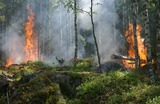
Wildfires are a contributing factor to greenhouse gas emissions. Scientists estimate that wildfires emitted 8 billion tons of CO2 per year for the past 20 years. Wildfires have risks and benefits that humans are impacted by. In this storyline, students will learn about the risks and benefits of wildfires, the science behind how fire occurs and the conditions that make a fire catastrophic. Students will evaluate local/regional fires to determine how human activities contribute to wildfires. Students will research how forest management decisions are made to decrease the negative impacts of wildfires and to decrease the amount of CO2 that is emitted from those fires.

Los incendios forestales son un factor que contribuye a las emisiones de gases de efecto invernadero. Los científicos estiman que los incendios forestales emitieron 8 mil millones de toneladas de CO2 por año durante los últimos 20 años. Los incendios forestales tienen riesgos y beneficios que afectan a los seres humanos. En este caso, los estudiantes aprenderán sobre los riesgos y beneficios de los incendios forestales, la ciencia detrás de cómo ocurren los incendios y las condiciones que hacen que un incendio sea catastrófico. Los estudiantes evaluarán los incendios locales / regionales para determinar cómo las actividades humanas contribuyen a los incendios forestales. Los estudiantes investigarán cómo se toman las decisiones de manejo forestal para disminuir los impactos negativos de los incendios forestales y disminuir la cantidad de CO2 que se emite por esos incendios.